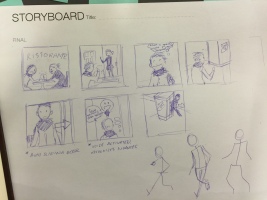How did taking the position of an Extreme User influence your thinking in relation to the design challenge? Was it different to how you usually generate ideas and empathy?
I’m not sure the reasoning as to why I seriously enjoyed this tutorial. I guess the feeling of not being limited to real world constraints really let my imagination fly. It’s also really nice to work with someone else who allows their imaginations to take off – we can come up with ridiculous, silly, and quite often very interesting ideas. I saw this exercise in a similar vain to storytelling, where you’re crafting a story and you are forced to be different or else your story would become cliché. By being at times absolutely ridiculous, we were able to craft actual, credible uses for an object (in this case a telephone box) that we know have become completely irrelevant. Since we were took the role of the sci-fi nerd, we could play with all sorts of ideas such as time travel, teleportation, memory saving. Also considering that this design would be something that would be created in the future, we could assume no technological limitations. I feel that this is a great way of planning a roadmap for products. Want to create the car of the future? Imagine the ultimate car with no limitations, then work your way backwards until it’s achievable with today’s technologies. I wonder if Tesla is actually doing that. Honestly, this was how I originally thought ideas were generated – all the user research, background research, affinity diagrams and personas are all new to me.
Did any of the other design thinking techniques (design provocation cards, stories, storyboards, etc.) help you to work through ideas and collaborate with your group members?
The storyboard was definitely one of the best ways to communicate an idea of how the product will work. Again with the storytelling references, it’s always better “to show rather than tell.” I guess that’s why tech companies always make these beautiful product videos – because showing how the products work is always better than verbosely pitching the concept to users. Even tech companies now require animated user interfaces to showcase how their intended mockup is supposed to work. There’s an entire subset in Tumblr that is dedicated to quirky and beautifully animated gifs of user interfaces (granted the majority of these would probably be nightmarish to code, but they’re very fascinating nonetheless). To be perfectly honest, we actually didn’t use the design provocation cards because we were too busy crafting this bizarre future, but we did pitch our ideas with stories. Stories really helped when clarifying what ideas might work and how certain features would be applied. Regardless of how ridiculous our setting or ideas are, ultimately it’s the tie to our human nature that will make the product engaging and compelling.
-Rezan

Leave a comment